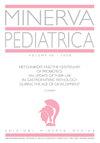Longitudinal effects of biopsychosocial variables on physical activity after menarche.
IF 2.6
4区 医学
Q2 Medicine
引用次数: 0
Abstract
BACKGROUND The aim of the current study is to analyze the longitudinal effects of certain biopsychosocial variables (socioeconomic status, body mass index (BMI), body image and well-being (QL)), measured at three different menarche stages (S1: before menarche, S2: soon after menarche, and S3: one year after S2), on physical activity and inactivity levels in early adolescence. METHODS The sample comprised 136 Brazilian teenagers (10-13 years old), showing BMI 18.98 kg/m2 at the initial assessment, who voluntarily participated in the study. Data concerning the following variables were collected in 2010 (S1), 2011 (S2) and 2012 (S3): family income (FI) (socioeconomic anamnesis), BMI (body mass and height), well-being (Autoquestionnaire Qualité de Vie Enfant Imagé) and body image (Body Shape Questionnaire). The physical activity and inactivity levels were measured in S3, only, through the International Physical Activity Questionnaire. The Pearson's correlation and the longitudinal path analysis technique were used to statistically analyze the data. RESULTS The main results indicated that just family income and BMI, measured soon after menarche (S2), showed significant effect on physical activity and inactivity levels. More specifically, family income has positively influenced (β = 0.25) physical inactivity levels and negatively influenced (β = -0.14) moderate physical activity levels, whereas BMI has positively influenced (β = 0.15) walking levels and negatively influenced (β = -0.13) vigorous physical activity levels. CONCLUSIONS These results suggest that the body image and well-being perceived by the teenagers at different menarche stages are not determining factors of their physical activity levels in early adolescence. On the other hand, the effects of socioeconomic status and body mass index on early adolescent girls' physical activity and inactivity levels depend on the assessment period.生物心理社会变量对月经初潮后身体活动的纵向影响。
背景:本研究的目的是分析在三个不同的初潮阶段(S1:初潮前,S2:初潮后不久,S3:初潮后一年)测量的某些生物心理社会变量(社会经济地位,体重指数(BMI),身体形象和幸福感(QL))对青春期早期身体活动和不活动水平的纵向影响。方法136名自愿参加研究的巴西青少年(10-13岁),初始评估时BMI为18.98 kg/m2。2010年(S1)、2011年(S2)和2012年(S3)收集了以下变量的数据:家庭收入(FI)(社会经济记忆)、BMI(体重和身高)、幸福感(Autoquestionnaire qualit de Vie Enfant image1)和身体形象(body Shape Questionnaire)。通过国际身体活动问卷,仅在S3中测量了身体活动和不活动水平。采用Pearson相关和纵向路径分析技术对数据进行统计分析。结果主要结果表明,家庭收入和初潮后测量的身体质量指数(BMI)对身体活动和不活动水平有显著影响。更具体地说,家庭收入对不运动水平有正面影响(β = 0.25),对中等运动水平有负面影响(β = -0.14),而BMI对步行水平有正面影响(β = 0.15),对剧烈运动水平有负面影响(β = -0.13)。结论不同月经初潮阶段青少年的身体形象和幸福感不是青少年早期体育活动水平的决定因素。另一方面,社会经济地位和身体质量指数对青春期早期女孩身体活动和不活动水平的影响取决于评估期。
本文章由计算机程序翻译,如有差异,请以英文原文为准。
求助全文
约1分钟内获得全文
求助全文
来源期刊

Minerva pediatrica
PEDIATRICS-
CiteScore
2.70
自引率
3.80%
发文量
1
审稿时长
>12 weeks
期刊介绍:
Minerva Pediatrica publishes scientific papers on pediatrics, neonatology, adolescent medicine, child and adolescent psychiatry and pediatric surgery. Manuscripts may be submitted in the form of editorials, original articles, review articles, special articles, letters to the Editor and guidelines. The journal aims to provide its readers with papers of the highest quality and impact through a process of careful peer review and editorial work.
 求助内容:
求助内容: 应助结果提醒方式:
应助结果提醒方式:


